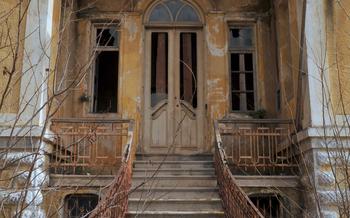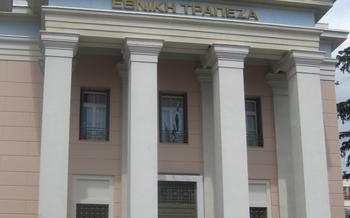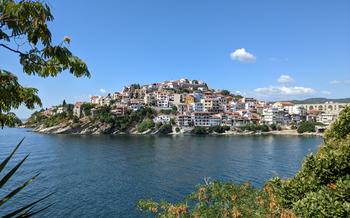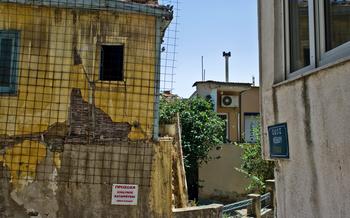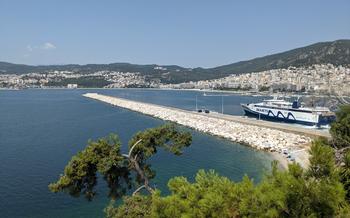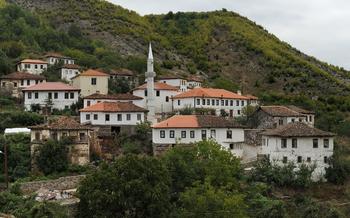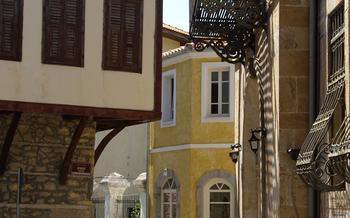
The Folklore Museum of Xanthi's Sarakatsani
- Location and Accessibility
- Architectural Charm
- Interactive Exhibits
- Traditional Costumes
- Handicrafts and Artifacts: A Showcase of Sarakatsani Ingenuity
- Historical Documents
- Educational Programs
- Cultural Events
- Research Center
- Community Involvement
- Seasonal Variations
- Accessibility for All
- Insider Tip
Location and Accessibility
The Folklore Museum of Xanthi's Sarakatsani is strategically situated in the heart of Xanthi's city center, making it easily accessible to visitors. It is conveniently located within walking distance of other popular attractions and landmarks, such as the Old Town, the Municipal Park, and the Tobacco Museum. This central location allows visitors to seamlessly integrate their visit to the museum with their exploration of Xanthi's other cultural and historical offerings.
Transportation to the museum is also convenient, with multiple options available. Visitors can choose to travel by bus, which has a stop right outside the museum. Alternatively, taxis and private vehicles can easily reach the museum's doorstep. Ample street parking is available in the surrounding area, ensuring a hassle-free visit for those who prefer to drive.
Architectural Charm
The Folklore Museum of Xanthi's Sarakatsani is housed in a stunning stone building that beautifully showcases traditional architectural elements and design. The exterior of the museum exudes an old-world charm, with its intricate carvings and arched doorways, while the interior boasts spacious rooms with high ceilings and exposed beams.
The museum's architects have skillfully blended traditional and modern elements to create a contemporary feel. Large windows allow natural light to flood the galleries, highlighting the vibrant colors and intricate details of the exhibits. The use of glass and steel accents adds a touch of modernity to the space, creating a harmonious balance between the past and the present.
The result is a museum that is both aesthetically pleasing and functional, providing visitors with a comfortable and engaging environment to learn about the rich cultural heritage of the Sarakatsani people.
Interactive Exhibits
The museum's exhibits are as engaging as they are informative, transporting visitors to the heart of traditional Sarakatsani life. Through multimedia displays, visitors can witness the seasonal migrations, experience the rhythm of daily life in a Sarakatsani village, and learn about their unique language and customs. Interactive workshops and activities further immerse visitors in the Sarakatsani culture, allowing them to try their hand at traditional crafts, learn traditional dances, and even taste traditional dishes. The Folklore Museum of Xanthi's Sarakatsani is not just a repository of history; it is a vibrant and interactive space where visitors can experience the living heritage of this fascinating community.
Traditional Costumes
The museum houses an impressive collection of traditional Sarakatsani costumes, each a masterpiece of intricate craftsmanship and vibrant colors. These costumes were not mere garments but symbols of identity, status, and cultural heritage.
The women's costumes, known as "foustanelles," are particularly elaborate, consisting of a long, pleated skirt, a fitted bodice, and a colorful apron. The skirts, often made of wool or cotton, are adorned with intricate embroidery and appliques, showcasing the women's artistic skills.
The men's costumes, though simpler in design, are no less striking. They typically comprise baggy trousers, a long-sleeved shirt, a waistcoat, and a distinctive hat called a "kamelaki." The kamelaki, made of sheepskin or felt, is a symbol of the Sarakatsani's nomadic lifestyle and their close connection to nature.
Beyond their aesthetic appeal, these costumes carry deep cultural significance. Each element, from the intricate embroidery to the choice of colors, holds symbolic meaning, reflecting the Sarakatsani's beliefs, traditions, and social customs.
Visitors can admire the vibrant hues and delicate handiwork of these traditional costumes, gaining a glimpse into the rich cultural heritage of the Sarakatsani people.
Handicrafts and Artifacts: A Showcase of Sarakatsani Ingenuity
The Folklore Museum of Xanthi's Sarakatsani is not only a repository of historical documents and cultural artifacts; it also serves as a vibrant showcase of the Sarakatsani's remarkable craftsmanship. Visitors can marvel at the intricate textiles woven by skilled hands, each thread imbued with stories of nomadic life. The vibrant colors and intricate patterns reflect the Sarakatsani's deep connection to nature and their surroundings.
In addition to textiles, the museum displays a diverse collection of pottery and jewelry, each piece a testament to the Sarakatsani's artistic talents. Handcrafted pottery, adorned with traditional motifs, showcases the ingenuity and practicality of this nomadic people. Visitors can admire the delicate silver jewelry, meticulously crafted with intricate filigree and adorned with colorful gemstones, reflecting the Sarakatsani's love of adornment and their ability to transform simple materials into objects of beauty.
Beyond the aesthetic appeal of these handicrafts, the museum offers visitors an insight into the traditional skills and techniques employed by the Sarakatsani. Interactive displays and demonstrations allow visitors to witness firsthand the processes involved in creating these exquisite pieces. Whether it's the intricate weaving of a traditional rug or the delicate shaping of a ceramic vessel, the museum provides a glimpse into the creative spirit of this remarkable community.
For those seeking a truly immersive experience, the museum offers the opportunity to purchase authentic Sarakatsani handicrafts, enabling visitors to take a piece of this rich cultural heritage home with them. These handcrafted items serve as not just souvenirs but as tangible connections to the Sarakatsani's way of life, ensuring that their traditions continue to live on beyond the museum walls.
Historical Documents
The museum houses a treasure trove of historical documents and photographs that provide a glimpse into the rich past of the Sarakatsani people. Chronicles of their migration and settlement, official records, and personal accounts offer visitors an opportunity to learn about the struggles and triumphs of this nomadic community. Through these documents, visitors can trace the Sarakatsani's journey from their mountainous origins to their eventual settlement in various regions of Greece. Photographs capture their traditional way of life, their colorful costumes, and their interactions with other cultures. These historical records serve as a bridge to the past, allowing visitors to understand the deep roots and rich heritage of the Sarakatsani people.
Educational Programs
The museum's dedication to education extends beyond its exhibits and artifacts. It actively organizes educational programs for students and visitors of all ages, fostering a deeper understanding of Sarakatsani history, culture, and traditions. In collaboration with local schools, the museum designs interactive workshops and seminars that bring the Sarakatsani heritage to life for young learners. These programs aim to instill a sense of appreciation for cultural diversity and promote the preservation of Greece's rich cultural heritage. The museum also welcomes adult visitors to participate in workshops and lectures, providing opportunities for continuous learning and cultural enrichment.
Cultural Events
The museum serves as a vibrant platform for cultural exchange and preservation through a series of captivating events held throughout the year. These events provide an immersive experience, allowing visitors to delve into the rich traditions of the Sarakatsani. Traditional music fills the air as talented musicians showcase the unique melodies and rhythms of the Sarakatsani culture. Visitors can witness the grace and agility of traditional dances, performed by skilled dancers adorned in elaborate costumes. Culinary demonstrations tantalize the taste buds, as chefs prepare mouthwatering dishes that have been passed down through generations. These events offer an exceptional opportunity to engage with the local community, learn about their customs, and celebrate the vibrant heritage of the Sarakatsani people.
Research Center
The Folklore Museum of Xanthi's Sarakatsani is not merely a repository of artifacts and exhibits; it also serves as a vibrant research center dedicated to the preservation and dissemination of Sarakatsani knowledge. Through collaborations with scholars, institutions, and universities, the museum actively engages in academic research and documentation projects. These initiatives delve into the history, traditions, and cultural heritage of the Sarakatsani people, shedding light on their unique way of life and contributing to a deeper understanding of their past and present. The museum's research center provides a platform for scholars to conduct in-depth studies, access primary sources, and share their findings with the broader academic community. This ongoing research not only contributes to the preservation of Sarakatsani culture but also ensures that their legacy continues to inspire and inform future generations.
Community Involvement
The Folklore Museum of Xanthi's Sarakatsani is not merely a repository of artifacts and exhibits; it is a vibrant hub where the Sarakatsani community actively participates in preserving and showcasing their rich heritage. Their involvement extends beyond mere participation to encompass decision-making and program development, ensuring the museum remains a true reflection of their culture.
This active engagement fosters intergenerational dialogue, where elders share their wisdom and experiences with younger generations, perpetuating the Sarakatsani legacy. The museum thus becomes a platform for cultural preservation, where traditions are not just displayed but also lived and breathed by the community.
Seasonal Variations
The Folklore Museum of Xanthi's Sarakatsani is a living and breathing institution that adapts to the changing seasons. In the spring, the museum comes alive with the colors of traditional Sarakatsani costumes and the sounds of traditional music. Special exhibitions showcasing the vibrant textiles and intricate jewelry of the Sarakatsani are often organized during this time. The summer months are a great time to experience the museum's outdoor spaces, where visitors can relax in the shade of the trees and enjoy the fresh air. Guided tours of the museum and the surrounding area are also offered during this period. As the autumn leaves begin to fall, the museum hosts workshops and seminars on Sarakatsani history and traditions. These events provide an opportunity for visitors to delve deeper into the culture and heritage of the Sarakatsani people. The winter season at the museum is a time for reflection and contemplation. Visitors can cozy up by the fireplace and peruse the museum's collection of historical documents and photographs, gaining insights into the past struggles and triumphs of the Sarakatsani. No matter the season, the Folklore Museum of Xanthi's Sarakatsani offers a unique and immersive experience for visitors of all ages.
Accessibility for All
The Folklore Museum of Xanthi's Sarakatsani is committed to providing an inclusive and accessible experience for all visitors. The museum features ramps and elevators to ensure that all floors are accessible to visitors with mobility impairments. Adapted exhibits, such as Braille labels and audio guides, are available for visitors with visual or hearing impairments. Additionally, the museum offers sign language interpretation services upon request. With these accessibility features in place, everyone can enjoy and learn from the museum's rich collection and exhibits.
Insider Tip
Venture beyond the museum walls and immerse yourself in the vibrant streets of Xanthi. Take a leisurely stroll through the Old Town, where you'll discover charming cafes, boutiques, and traditional tavernas. Engage with the locals, learn about their customs, and savor the delicious regional cuisine. Explore the city's other cultural gems, such as the Archaeological Museum of Xanthi, the Municipal Gallery, and the Tobacco Museum. Xanthi is a city that pulsates with life and history, offering a captivating blend of cultures and experiences. Embrace its unique charm and create memories that will last a lifetime.
